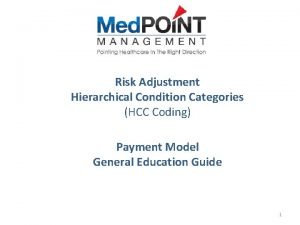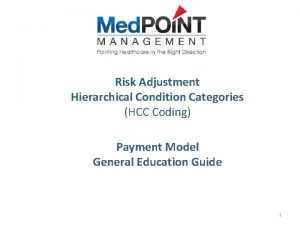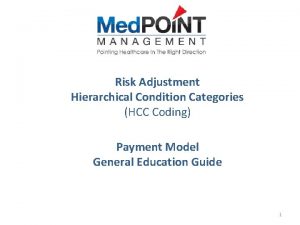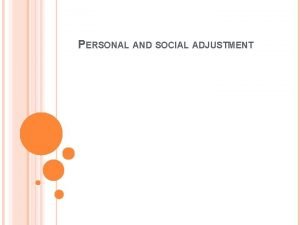HCC Coding Presentation June 2016 Risk Adjustment and







- Slides: 7

HCC Coding Presentation June 2016

Risk Adjustment and Hierarchical Condition Category (HCC) Coding • Mandated by the Centers for Medicare and Medicaid Services (CMS) in 1997. • Model assigns a risk factor score to individuals with serious or chronic illness based upon a combination of the individual’s health conditions (ICD-10) and demographic details. • Documentation must support the presence of the condition and indicate the provider’s assessment and/or plan for management of the condition. • This must occur at least once each calendar year in order for CMS to recognize the individual continues to have the condition. Notes taken from Security Health Plan Provider Manual

Risk Adjustment & HCC Documentation Basics Document on each condition the patient has that influences your ability to evaluate or treat the patient including: • Pertinent conditions • Chronic conditions • Active status • “History of” or “Past” conditions • Conditions that require two codes billed together Notes taken from Security Health Plan Provider Manual

Risk Adjustment & HCC Documentation Basics • Documentation of all conditions being: • Monitored/managed • Evaluated • Assessed/addressed • e. g. , “Have you followed up with your oncologist? ” • Treated • Considered in your care of the patient • e. g. , patient has diabetes with kidney disease. I will prescribe something other than NSAID OR recommend NSAID with cautions Notes taken from Security Health Plan Provider Manual

Risk Adjustment & HCC Documentation Basics • Pertinent Conditions: • Document and code for any patient conditions that are • • • Present but stable Managed on therapy Require observation Require referral to another provider for management Influence your decision-making in care of the patient • Avoid documenting “history of” when the condition currently exists. In ICD 10 coding language, “history of” means that the patient no longer has the condition, in which case it cannot be coded as an active disease Notes taken from Security Health Plan Provider Manual

Risk Adjustment & HCC Documentation Basics • Chronic conditions: • • Document chronic conditions annually, even when stable with treatment Document that the condition is chronic Document severity/stage of condition (i. e. stage IV chronic kidney disease/major depression) Document associated conditions or complications and relationship to the • underlying chronic condition (i. e. diabetic retinopathy, cirrhosis secondary • to alcoholism) Notes taken from Security Health Plan Provider Manual

Risk Adjustment & HCC Documentation Basics • Active status: Conditions that are present and unresolved or unlikely to resolve need to be documented at least annually. CMS considers the condition resolved if not evaluated and coded at least once/calendar year. • Forever codes – conditions that do not go away and patients are expected to have forever, e. g. , amputation, transplant, alcoholism in remission, CHF (compensated) • Might be forever codes include: ostomy, cirrhosis, diabetes, hepatitis, , paraplegia/quadriplegia (be specific) • “History of” or “Past conditions” • History of cancer, if not in active treatment and does not have active disease. Cancer on long-term therapy is active cancer when therapy is not prophylactic • History of stroke or CVA – document deficits and history of incident (e. g. , hemiplegia secondary to CVA) • Conditions that require 2 codes billed together • Diabetes manifestations - nephropathy, neuropathy • Hypertensive renal disease – document both the hypertension and the renal disease • Infections, e. g. , UTI and E. Coli Notes taken from Security Health Plan Provider Manual













